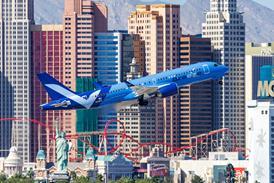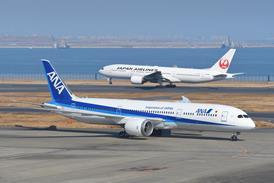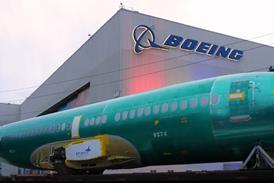GUY NORRIS/ LOS ANGELES
Two initial versions to be pitched against Airbus A330-200, but with better fuel consumption and faster cruise speed
Details of Boeing's family plan for the new 7E7 aircraft programme are emerging, with two initial members dubbed the 7E7-300X and -400X now proposed for the medium- capacity, long-range market.
Potential customers are being briefed on a 7E7-300X version seating 228 passengers in three classes, with a design range of 14,430km (7,800nm), and a stretched -400X version seating 268 passengers, with a range of around 13,420km. Boeing says "initially it would be two family members", but adds: "We would be able to launch two at the same time, but it's doubtful."
The new details reveal the 7E7 is targeted firmly at the Airbus A330 and particularly the -200 market sector. Performance targets include more range and 23% better fuel consumption per passenger than the A330-200. "The target for fuel burn per trip is equally compelling," says Boeing. Other targets are believed to include fuel consumption per passenger 15%-20% better than the 777-200 and engine specific fuel consumption 16% better than the 767-300ER. Cruise speed is also aimed at Mach 0.85 to 0.89, or relatively close to the 747-400 and faster than the A330.
The required engine thrust bracket has been confirmed at 66,000-69,000lb (294kN-307kN). Although none of the engine makers are willing to comment on these requirements, it puts the new 7E7 powerplant well within the earlier thrust targets already anticipated, and confirms that the high bypass study engines will form the basis for a next-generation family of CF6 and PW4000 replacements as well as a Trent follow-on.
It has also been revealed that a decision on whether to use a large, all-composite wing instead of a conventional design is due by mid-year. "What it looks like is less important than what it's made of," says Boeing, which adds that the technology group studying advanced systems and materials for Sonic Cruiser "didn't miss a beat" when switched to the 7E7 late last year. Prospective materials for the 7E7 structure include Tigre (titanium-graphite), a fibre-metal laminate of interleaved titanium foil and composite fibre conceptually similar to the GLARE material being used by Airbus for the fuselage of the A380.
A key part of the decision will depend on the manufacturing cost of the materials, a battle that became tougher in 2002 as traditional aluminium manufacturers presented Boeing with data on a range of new alloys in development.
Source: Flight International























